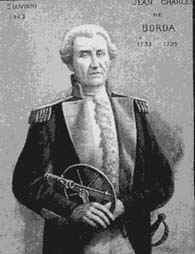<Back to Index>
- Mathematician Jean Charles de Borda, 1733
- Instrument Maker Bartolomeo Cristofori di Francesco, 1655
- Dictator of Iraq Abdul Karim Kassem, 1914
PAGE SPONSOR

Jean-Charles, chevalier de Borda (May 4, 1733 – February 19, 1799) was a French mathematician, physicist, political scientist, and sailor.
Born in the city of Dax, in 1756 Borda wrote Mémoire sur le mouvement des projectiles, a product of his work as a military engineer. For that, he was elected to the French Academy of Sciences in 1764.
Borda was a mariner and a scientist, spending time in the Caribbean testing out advances in chronometers. Between 1777 and 1778, he participated in the American Revolutionary War. In 1781, he was put in charge of several vessels in the French Navy. In 1782, he was captured by the English , and was returned to France shortly after. He returned as an engineer in the French Navy, making improvements to waterwheels and pumps. He was appointed as France's Inspector of Naval Shipbuilding in 1784, and with the assistance of the naval architect Jacques-Noël Sané in 1786 introduced a massive construction programme to revitalise the French navy based on the standard designs of Sané.
In 1770, Borda formulated a ranked preferential voting system that is referred to as the Borda count. The French Academy of Sciences used Borda's method to elect its members for about two decades until it was quashed by Napoleon Bonaparte who insisted that his own method be used after he became president of the Académie in 1801. The Borda count is in use today in some academic institutions, competitions and several political jurisdictions. The Borda count has also served as a basis for other methods such as the Quota Borda system and Nanson's method.
Another of his contributions is his construction of the standard metre, basis of the metric system to correspond to the measurements of Delambre.
As
an
instrument maker, he improved the reflecting
circle (invented by Tobias
Mayer) and the repeating
circle (invented by
his assistant, Etienne
Lenoir), the latter used to measure the meridian
arc from Dunkirk to Barcelona by Delambre and Méchain. With the
advent of the metric system after the French Revolution it was decided
that the quarter circle should be divided into 100 degrees instead of
90 degrees, and the degree into 100 seconds instead of 60 seconds. This
required the calculation of trigonometric tables and logarithms
corresponding to the new size of the degree and instruments for
measuring angles in the new system. Borda
constructed instruments for measuring angles in the new units (the
instrument could no longer be called a "sextant") which was later used
in the measurement of the meridian between Dunkirk and Barcelona by
Delambre to determine the length of the metre.
The
tables of logarithms of sines, secants, and tangents were also
required for the purposes of navigation. Borda was an enthusiast for
the metric system and constructed tables of these logarithms starting
in 1792 but their publication was delayed until after his death and
only published in the Year 9 (1801) as Tables of Logarithms of
sines, secants, and tangents, co-secants, co-sines, and co-tangents for
the Quarter of the Circle divided into 100 degrees, the degree into 100
minutes, and the minute into 100 seconds to ten decimals, and
including his tables of logarithms to 7 decimals from 10,000 to 100,000
with tables for obtaining results to 10 decimals. The
division of the degree into hundredths was accompanied by the division
of the day into 10 hours of 100 minutes and maps were required to show
the new degrees of latitude and longitude. The Republican
Calendar was
abolished by Napoleon in 1806, and presumably with it the 400-degree
circle.